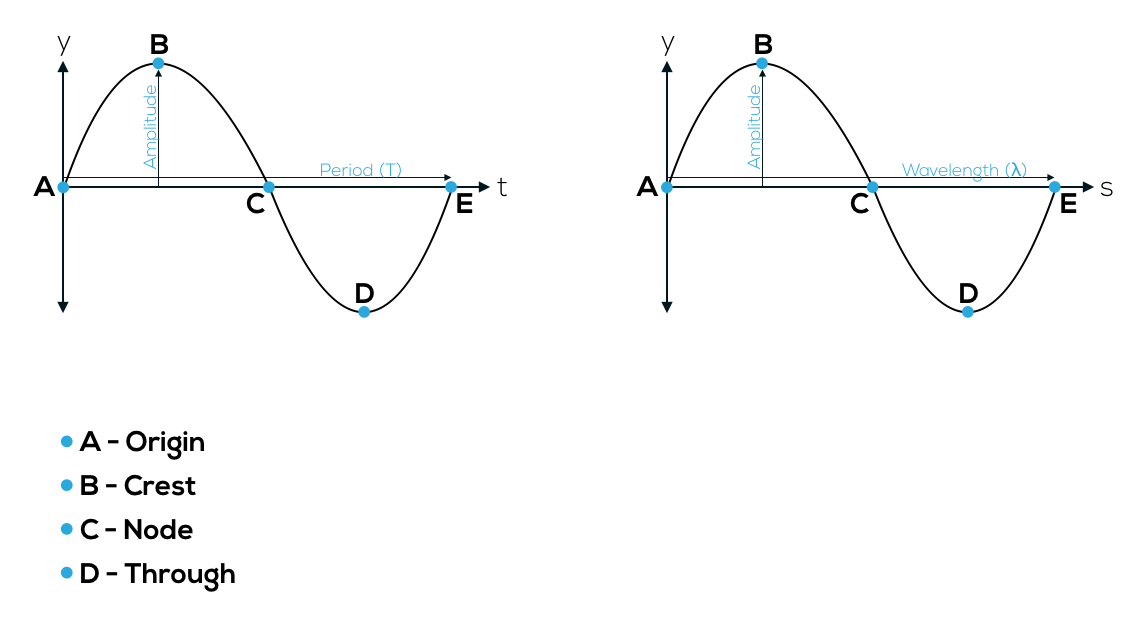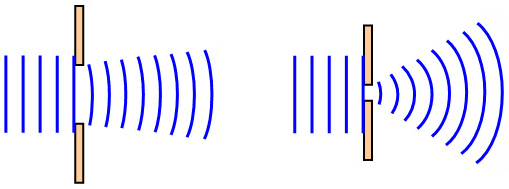Wave terminology
Wave: any regularly recurring event, such as surf coming in toward a beach, that can be thought of as a recurring disturbance, propagating through a medium. Waves are characterized by wavelength, frequency, and the speed at which they move.
Electromagnetic waves: a wave produced by the acceleration of an electric charge and propagated by the periodic variation of intensities of, usually, perpendicular electric and magnetic fields.
Types of waves
Travelling wave: a wave in which the energy travels along and appears to move as the particles move.
Transverse wave: a wave in which the particles vibrate perpendicular to the direction the wave is travelling.
Longitudinal wave: a wave where the particles vibrate parallel to the direction of the wave.
Wave anatomy
Amplitude: maximum displacement from center and also how much energy is being given = maximum displacement x0
Crest: maximum positive displacement
Trough: maximum negative displacement
Equilibrium position: point of zero displacement

Wave equation
As speed is equal to distance over time, we can calculate the speed of a wave to be the distance it covers over in a certain time.
v=/T
This then becomes:
v=f
|
Properties
|
Definition
|
Symbol
|
formula
|
Units
|
|
Wavelength
|
Distance between two wave crests
|
(lambda)
|
=vf
|
Metres - m
|
|
Period
|
Time it takes for a wave to repeat
|
T
|
T=v/
|
Seconds - s
|
|
Frequency
|
Number of oscillations per second
|
f
|
f=1/T
|
Hertz - hz
|
|
Velocity
|
How fast the wave is travelling. For electromagnetic waves this is the speed of light.
|
v
|
v=f
|
ms-1
|
Wave Phase
Phase difference: the relative displacement of two waves, given in fractions of the wavelength or radians, depending on the unit of the x axis .
E.g A phase difference of λ/2 means the wave has being shifted by half its wavelength
|
Phase type
|
Description
|
Phase difference
|
Diagram
|
|
Radians(rad)
|
Wavelengths(λ)
|
|
In phase
|
The two waves are lined up exactly so that they are the same.
|
0 or 2ℼ
|
0 or 1
|
|
|
Out of phase
|
The waves don’t line up, so that there is a phase difference.
|
0-ℼ or ℼ-2ℼ
|
0-0.5 or 0.5-1
|
|
|
Completely out of phase
|
The crests line up with the troughs. The wave has been shifted by exactly half the wavelength
|
ℼ
|
0.5
|
|
Simple harmonic motion
What is it?
Simple harmonic motion (SHM) is an oscillating movement through a central point where the restoring force is proportional to the displacement.
For something to be simple harmonic motion the acceleration must be highest when the displacement is smallest. a ∝ -x
Restoring force: Any Force that is proportional to the opposite of a displacement. All restoring forces can drive simple harmonic motion.
Hooke's law and SHM
To find the amount of force exerted by a spring at a given displacement you can use hooke's law.
Hooke's law: F = -kx
- k: spring constant ,
- x: displacement
We can then use hooke's law to prove a ∝ -x:
- As force can be derived with two equations, we can create a simultaneous equation
- We then set the equations equal to each other
- Finally we rearrange to make acceleration the subject
Sound waves
Sound waves are caused by objects vibrating in a medium. The oscillating movements of the vibratings push and pull the air creating waves.
For example the way speakers work is that the cone pushes outwards creating a compression, then as it retracts it separates the air molecules creating a rarefaction.
Rarefaction: where particles are separated
Compression: is where particles are compressed.
Sound waves are longitudinal as they are created by particles vibrating parallel to the direction of travel.
Wave fronts
Wavefront: for transverse waves these are the crests of the waves, for longitudinal waves these are the compressions.
Rays: these are vectors drawn from the source outward and show the direction of the wave speed or velocity. They are always perpendicular to the wave front
Types of wavefronts
When drawing wave fronts they should always be drawn from a top-down view
Plane wavefronts: These are wavefronts which are just straight lines, this is the form electromagnetic waves take.
Circular wavefronts: These wavefronts form concentric circles. They are the more common type found in nature, as all waves created by vibrations expanding outwards in all directions.
Interference
Wave interference is the addition of two or more waves passing simultaneously through a medium. It can be either constructive or destructive , If two waves come together from opposite sides, they construct one super pulse and then pass through each other.
Constructive interference: When two waves build each other up in intensity.
- Phase difference: 0-¼ or ¾-1 wavelengths
- Maximum construction is when they are in-phase
Destructive interference: When two waves break each other down in intensity. Noise cancelling headphones use destructive interference to cancel out incoming sound waves so that you hear don’t hear them.
- Phase difference: ¼-½ or ½ -¾ wavelengths
- Maximum destruction is when they are completely out of phase. The two waves destroy each other.
Wave energy
Maximum Kinetic energy = ½ * change in mass * velocity squared
Maximum Potential energy = ½ * Spring constant * Amplitude squared
Total energy = ( ½ x mass * velocity at x displacement squared ) + ( ½ * spring constant * x displacement squared)
Intensity
- Intensity is the rate energy is being transmitted per unit area and is measured in (wm^-2)
- L = power /area
Reflection and refraction
Normal: The line in which the angle is taken from. It’s perpendicular to the surface for reflection and parallel for refraction
Angle of incidence: Angle made by the wave and the normal line before hitting the medium
Angle of reflection: Angle made by the wave and the normal line After hitting the medium.
Reflection
Reflection occurs when a wave meets a boundary, such as a solid object, or a change in the medium, and is at least partially diverted backwards.
We measure the angle of reflection in respect to the perpendicular angle coming off the surface. The relationship between the angle of incidence and the angle of reflection is simple
- Angle of incidence = angle of reflection.
Note: Wavelength and frequency do not change during reflection.
Refraction
Refraction occurs when a wave hits a boundary. The wave is slowed down by the medium and changes angle. In refraction as the frequency cannot change the wavelength gets smaller.
Critical angle: is that incident angle at which the angle of refraction is 90°
Total internal refraction
This occurs when a wave moving in a optically dense region arrives at a boundary with a less dense medium it is possible to have all of the light reflected - trapping it inside. This is the principle behind fiber optics.
Internal refraction occurs when the angle with the normal is more than the critical angle
Snell's Law
Snell's law relates the refractive indexes in two mediums, to their angles
refractive index nm :Is defined to be the ratio of the speed of light in a vacuum c to the speed of light in the medium vm
Snell's law gives us a relationship between the indices of refraction and the critical angle
- N1Sinc=N2Sin90=N2(1)
- N1Sinc=N2
- Sinc= N2N1
Diffraction
The process by which a wave is spread out as a result of passing through a narrow aperture or across an edge, typically accompanied by interference between the waveforms produced.

Lenses
Lenses bend all light rays using the principle of refraction
Converging lenses bend stuff towards a focal point.
View count: 12386